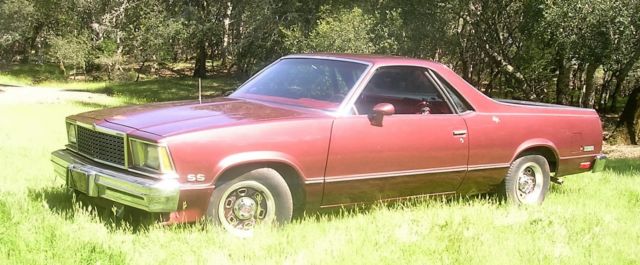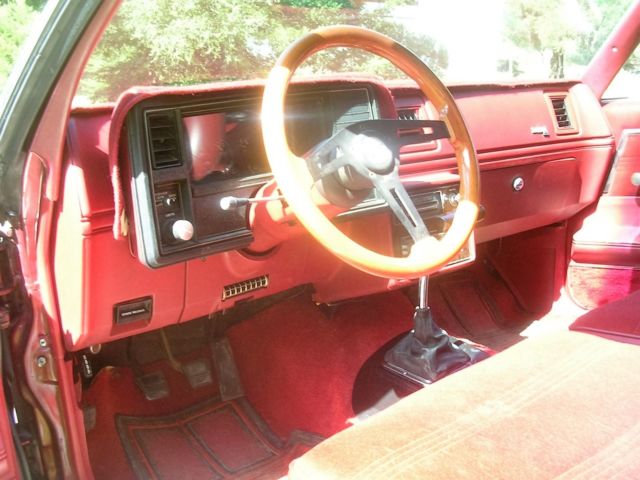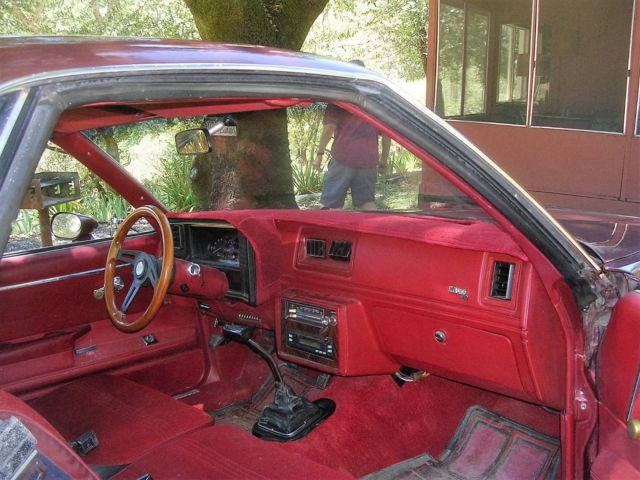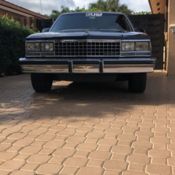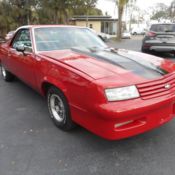1978 El Camino SS
Technical specifications of Chevrolet El Camino 1978
| Price: | - |
|---|---|
| Condition: | Used |
| Item location: | Santa Rosa, California, United States |
| Make: | Chevrolet |
| Model: | El Camino |
| SubModel: | SS |
| Type: | Standard Cab Pickup |
| Trim: | SS (Super Sport) |
| Year: | 1978 |
| Mileage: | 135,185 |
| VIN: | 1W80L8K472828 |
| Color: | Burgundy |
| Engine size: | 350 RHS Crate engine |
| Number of cylinders: | 8 |
| Power options: | Air Conditioning |
| Fuel: | Gasoline |
| Transmission: | Manual |
| Drive type: | RWD |
| Interior color: | Burgundy |
| Drive side: | Left-hand drive |
| Options: | CD Player |
| Vehicle Title: | Clear |
| You are interested? | Contact the seller! |
Description
This is a genuine factory SS model originally sold in Michigan. It is equipped with a 350 cid engine, 4-speed manual transmission, air conditioning, front disc brakes, cold air carburetor intake and the SS trim package.
The second owner is a friend of mine I have known since we were 8 years old in the third grade. He bought this El Camino in the mid 1980s from the original owner and used it as a daily driver. He added a RHS (Racing Head Service, a division of Competition Cams) 350 cid “crate engine” that was professionally installed and other minor upgrades like an Accel distributor, a wood rimmed steering wheel and a true dual exhaust system. The engine is what RHS calls a “268 High Energy Engine” because it is equipped with a Competition Cams “268 High Energy” hydraulic camshaft. This camshaft is completely streetable but has a very robust mid range power delivery that is really fun to drive. The cylinder heads are ported for street use by RHS. I have the original paperwork for the RHS engine. It has an Edelbrock “Performer” intake manifold and the correct Quadrajet carburetor for this year and model. My friend had the El Camino repainted an original maroon color. The upholstery is original except for a new, perfectly color matched headliner. The chrome is all original and near perfect.
In 1997 I bought the El Camino for my older son who was going to graduate from high school in 1998. He had been accepted to the Pre-med/Medical program at the University of California at Riverside and needed a vehicle capable of reliable transportation during his college years that was also capable of carrying his off road race motorcycle to organized race events on the Mojave Desert. The El Camino had not been driven much during the last few years my friend owned it. Because my son was going to be away at college we inspected and replaced the few questionable items with new parts like the radiator, radiator hoses, V-belts. Heater core and universal joints. These all have lifetime warranties. I also put a new rear bushing and new real seal in the transmission. All if this maintenance is documented in a log book.
Being a long time auto restorer and street rod builder it seemed to me that the original Quadrajet carburetor had leaner than optimum settings, as was the practice of the 1970s to meet emissions requirements. Because the Quadrajet carburetor is quite complicated and time consuming to rejet for improved performance I purchased another Quadrajet identical to the original and changed its jets and metering rods for a slightly richer mixture throughout the engine’s operating range. The purpose of getting a second carburetor was to be able to have one carburetor for improved performance and another to quickly install to pass a “smog check”. In this case changing carburetors is a vastly quicker task than changing jets and metering rods. The results of the carburetor change were very pleasing and resulted in improved performance, improved fuel economy (usually about 19 mpg on the highway), cooler running and the engine no longer needed 91 octane gasoline. It runs fine on 89 octane gasoline.
Then, out of the blue, in 1998, my son joined the Marine Corps and I suddenly found myself with this newly freshened up El Camino and a new 250cc Honda race bike I had just bought for my son. I sold the new race bike immediately but couldn’t decide what to do with the El Camino. I really had no use for another vehicle but couldn’t quite bring myself to sell it because it came from a long time friend and it is such a nice specimen. So I kept it licensed until 2002 even though it was rarely driven and then I put it on “Non-operation” status with the California Department of Motor Vehicles. That means it has no back license fees due if a California resident buys it. I has been kept in my garage and not driven at all since 2002. The only thing it needs to be roadworthy in its new life is new tires. The Michelin tires on it have almost no treads wear but they are over 20 years old. I know from personal experience that old tires can have sudden tread separations that can cause loss of control of the vehicle and can also do major body damage as the loose tread whips around in the wheel well.
This year my wife and I decided it was time for the El Camino to go. Although the engine had not been run for a long time, I put the battery from my tractor in the El Camino and to my surprise it fired up instantly and after a few seconds of lifter clatter it settled down to a smooth, quiet idle. When I stepped on the brake pedal it went to the floor and emitted a “woosh” sound, indicating a problem with the power booster. I replaced the brake booster, master cylinder and wheel cylinder internals with new parts. I also replaced the air filter, PCV air filter and did an oil change. The clutch is not “stuck” to the flywheel from disuse and it releases cleanly. Now the El Camino is ready for its new life.
